
Chapter 2. System Overview
Thank-you for purchasing a Güralp Breve Ocean Bottom Seismometer.
This section describes the key components of a full Breve OBS system. The Breve OBS unit is the main standard product in the system; other components and accessories can be purchased optionally. Please check your order confirmation to see which components were purchased by your organisation.
2.1 Overview of key features
Deployment
Stable design with low centre of gravity
Dual aluminium pressure vessels (sensor+digitiser and battery)
High-density polyethylene (HDPE) frame and cover
Operation over all static tilt angles
Installation by rope, using a non-specialist vessel
Recovery via pop-up buoy (acoustic signalling)
Operated by touch-screen Deck Control Unit (see Section 2.3) with GPS time synchronisation
Data recovery via FireWire disk for instant access
Response and accuracy
Acceleration response of 10 seconds to 100 Hertz
Timing accuracy is managed by an internal real-time clock which is synchronised with GPS upon deployment and upon recovery
Data
Export to GCF and miniSEED for compatibility with SCREAM, Antelope, Earthworm, SEED or CD1.1.
60 GB Flash memory storage
Duration
Six month battery capacity
2.2 Breve OBS unit
2.2.1 Overview
The Güralp Breve is an ocean-bottom, broadband seismometer with customised acceleration response. This OBS has been developed for applications at depths of up to 100 metres (rope deployment) or 2000 metres (ROV deployment). The internal seismometer sensors can operate over any angle of static tilts. The acceleration response to allow filtering of long-period wave and marine traffic noise associated with shallow water environments, and enhances the sensitivity of weak, high frequency seismic signals caused by local micro-earthquakes.
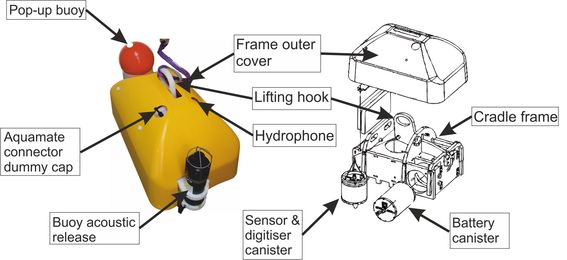
Main external features (left) and internal components (right) of the Breve OBS
The portable OBS is a stand alone instrument composed of a seismometer, a hydrophone, a digitiser with flash memory storage and a battery pack. To avoid the use of expensive ROV during the installation, the OBS has been fitted with an acoustic release and a pop-up buoy that will be released at the instrument recovery.
As shown in the previous drawing, the system comprises a High-density polyethylene (HDPE) frame which holds in place a frame cover and two aluminium canisters: one containing the accelerometer, digitiser, and SoH board, and another canister containing the battery pack. The lids of both canisters comprise a ventilation screw and a connector.
2.2.2 Seismometer and digitiser canister
The sensor installed in the OBS is a 3-component accelerometer, with a flat frequency response between 0.1 Hz and 100 Hz and sensitivity of about 5 V/m/s2. The digitiser is a Guralp CD24 unit, which can record four primary input channels at sample rates of up to 1000 sps.
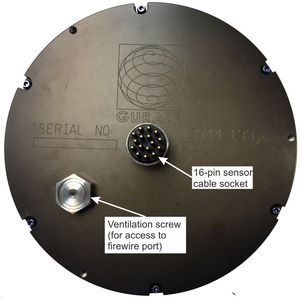
Lid of the sensor/digitiser canister
The sensor canister is assembled in three parts, the lid assembly, the tube and the base assembly. The lid assembly includes the digitiser and the base assembly includes the analogue sensor, its feedback electronics and its State-of-Health processor (SoH), as shown below.

The logical organisation is shown in simplified form below:
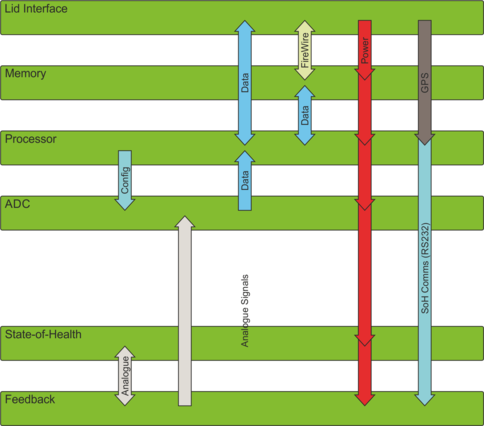
The same RS232 channel is used for both GPS NMEA data and serial communications with the State-of-Health processor. The system automatically detects the nature of any traffic on this line and routes it accordingly.
2.2.3 Battery canister
The Breve OBS comprises a second canister containing Lithium-ion polymer batteries that are suitable for deployments of up to 6 months.
The lid of the battery canister has a 4-pin power cable socket and a ventilation screw.
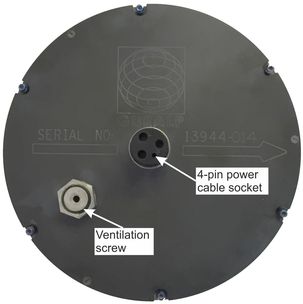
Lid of the battery canister
2.2.4 Frame cover
The HDPE frame cover helps to protect the OBS sensor from sea floor ambient noise (e.g. current flow, tidal energy, wave action), increasing the recording performance.
2.2.5 Hydrophone
A hydrophone (accessible from a small hole in the frame cover) is moulded into the octopus cable connecting the sensor package and the battery canister. The hydrophone has a flat frequency response between 2Hz and 30 kHz, with a sensitivity of -165dB re: 1V uPa (562V/Bar).
2.2.6 Concrete slabs
To balance the battery canister weight and to move the OBS unit’s centre of gravity onto the vertical axis of the lifting hook, two concrete paving slabs are fitted inside the plastic frame.
2.2.7 Release beacon
The Breve OBS comes with an Applied Acoustics 1519 Release Beacon. Upon instrument recovery, an acoustic command is sent from the ship to the acoustic release attached to the OBS. This will release a PVC spherical buoy which will bring a recovery line to the surface. For more details about the release beacon, the user is referred to the Quick Start Guide of the Applied Acoustics 1519 Release Beacon, REL-1519-8000-1_1519 (available from Guralp on request).
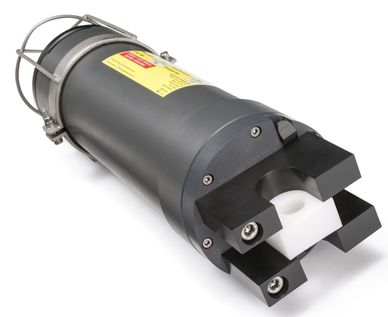
Release beacon
2.3 Deck control unit
2.3.1 Description
The deck unit provides the main interface to the Breve OBS and can be optionally purchased as part of a Breve OBS system. At least one Deck Control Unit is required to operate the Breve OBS units.
Up to four Breve OBS units may be connected at one time, using the Subconn connectors on the left hand side of the unit.
The deck unit contains an integrated touch-screen PC which is pre-loaded with Scream software (see Guralp manual MAN-SWA-0001 for more details). In addition to the PC's standard battery, a lithium battery pack has been installed in the deck unit for long-term deck operations without mains connection. Using the power jack at the top right of the front panel both the additional battery and the PC's battery can be recharged. The PC's battery will be charged from the additional lithium battery whenever the switch “POWER ON/OFF” is on the “ON” position. If the switch is on the “OFF” position the PC can still be turned on using the aluminium toggle, but will be powered from its own standard battery.
To completely switch off the deck unit, turn off (shut-down) the PC from within the operating system and move the switch to the “OFF” position.
The serial consoles of connected Breve OBS units appear on the PC as USB COM ports that are assigned as “COM**”, where “**” represents the port number assigned in the same order as the sensor inputs (left to right).
Note: An external PC or laptop can be used instead of the integrated touch-screen PC. To do this, connect the external PC to the USB type B connector on the front panel of the deck unit and press the red button to toggle between internal and external mode.
The deck unit provides a connector for a Güralp GPS receiver. This provides power for the receiver and accepts the PPS and NMEA signals which are used for synchronisation of the OBS units' real-time clocks.
When using a GPS receiver, the switch marked “Comms” must be in the “GPS” position. The red “PPS” indicator will flash once per second and the green “NMEA” indicator will pulse to indicate that signals are being received from the GPS unit.
When the switch marked “Comms” is in the “SoH” position, the serial lines which are normally used for GPS signals are connected instead to the state-of-health (SoH) processors within the first connected Güralp Breve unit and Scream's built-in terminal emulator facility can then be used to interact directly with this instrument.
By default, it is recommended to leave the switch in the “GPS” position and not the “SoH” position.
Note: Due to the splash-proof design of the Deck Control Unit at integrated PC, heat dissipation can be slightly reduced, so the PC can very occasionally power off in high temperature environments of more than 35-40ºC. In the event of this, we recommend connecting the Deck Control Unit to an external PC or laptop via the USB connection to allow full Deck Control Unit operations.
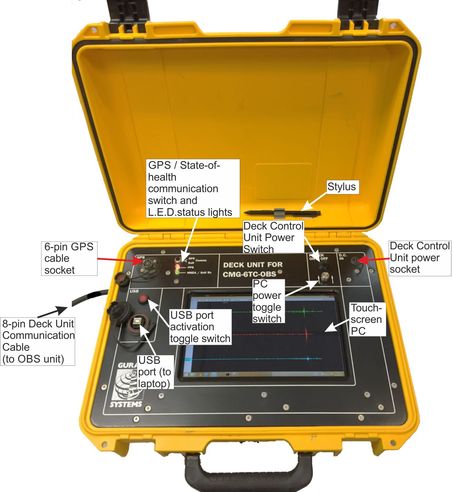
2.4 Battery charger
A battery charger (OEM-BAT-C013) can be optionally provided with a set of Breve OBS units. The charger has a display providing information about the Voltage and Current.
For more details on the battery charger, please contact Guralp.
2.5 Acoustic command module
An acoustic command module may be optionally provided with a set of Breve OBS units. The model of this unit is the Applied Acoustics PAM 3510. The unit can be housed in a water-proof rugged enclosure with a clear LCD allowing the unit to be used on-deck.
For more details, the user is referred to the Operation Manual of the Applied Acoustics PAM Portable Operation Manual PAM-3510-8600-6_3510 (available from Guralp on request).
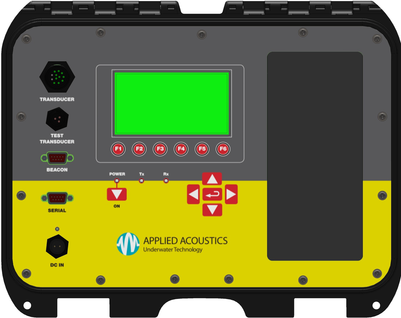
Main panel of the Applied Acoustics PAM 3510 Console Unit
2.6 Applications of the Breve OBS
Plate Tectonics and active fault studies
Subsea hazard mitigation
Permanent reservoir monitoring
Passive seismic monitoring
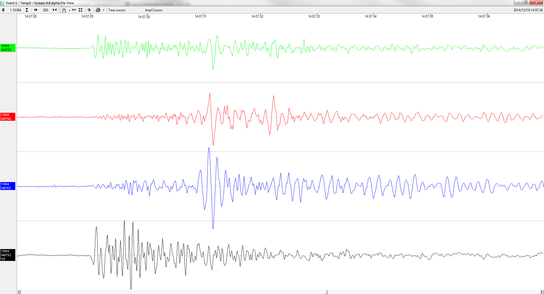 Recordings of a magnitude 1.1 earthquake on a Guralp Breve unit located ~4 km from the event’s epicentre using a sensor with a high sensitivity.
Recordings of a magnitude 1.1 earthquake on a Guralp Breve unit located ~4 km from the event’s epicentre using a sensor with a high sensitivity.